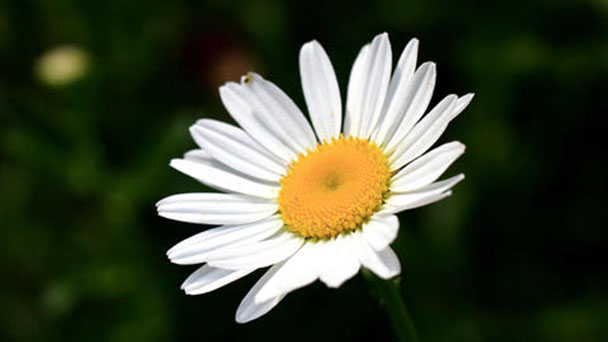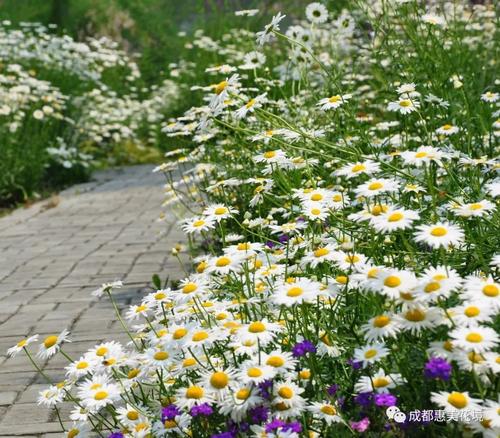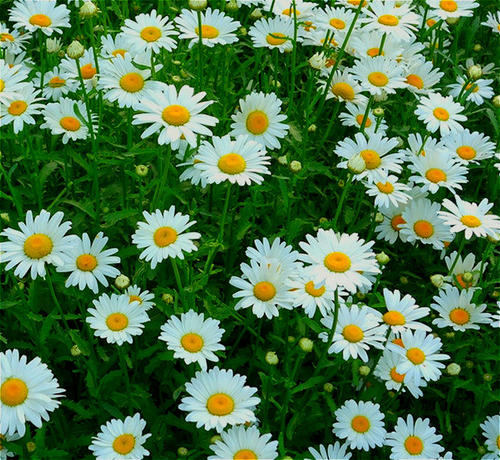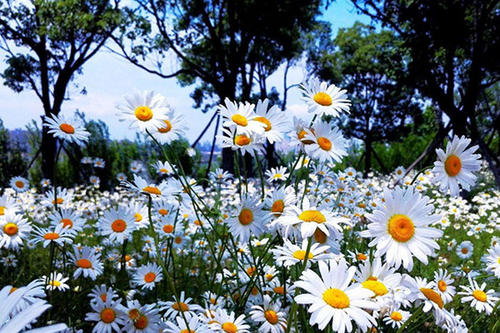Oxeye daisy (Leucanthemum vulgare) profile
Written by Maggie
Oct 28 2021

Oxeye Daisy, scientific name Leucanthemum vulgare, also called white daisy, whiteweed, field daisy, marguerite, poorland flower, is a perennial herb in the Compositae family, growing 15-80 cm tall. Oxeye Daisy stems are erect, usually unbranched, tomentose or curly to glabrous. Basal leaves are anthesis survival, long elliptic, oblateolate, obovate or ovate, base cuneate, tapering long stalk, stalk longer than leaf itself, margin rounded or obtuse serrate. Both sides of all leaves of Oxeye Daisy are glabrous, glandular spots inconspicuous. Inflorescences solitary at apex of stem, with long pedicels, or 2-5 cauline heads, arranged in loose corymbs. Involucral diameter is 10-20 mm. Bracts are entire glabrous, margin white or brown membranous. Achene is 2 -- 3 mm long, uncrested or liguulate. Achene with lateral crown teeth up to 0.4 mm long.
Oxeye daisy picture

Morphological characteristics of oxeye daisy
Stems
Oxeye Daisy is a perennial herb, 15 to 80 cm tall. The stem is erect, with a tiny flower head (not more than 5 cm) at the top of the stem, consisting of about 20 white ligulate flowers and numerous yellow heart flowers. Stem is mostly unbranched and grows laterally from root.
Leaf
Oxeye Daisy's leaves are dark green on both sides. Basal leaves and middle leaves are stipulated, obovate to spatulate, and serrate. Upper leaves are shorter, sessile and grow along stems. Oxeye Daisy has a large number of flat seeds without crested hairs. Basal leaves flowering survival, long elliptic, oblanceolate, obovate or ovate, 3 -- 8 cm long, 1.5 -- 2.5 cm wide, base cuneate, tapering long stalks, stalks longer than leaf itself, margin round or obtuse serrate. In the lower part of the stem and leaves long elliptic or linear long elliptic, narrow to the base, auricular or auricular enlargement half holding stem, the middle part of the following or near the base sometimes pinnate shallowly. Upper leaves of Oxeye Daisy are tapered, sometimes pinnately lobed. Both sides of all leaves are glabrous, glandular spots inconspicuous.
Flowers
Inflorescences of Oxeye Daisy are solitary at stem apex, with long pedicels, or stem 2 -- 5 heads arranged in loose corymbs. Involucral diameter is 10 -- 20 mm. Bracts whole are glabrous, margin white or brown bashful. The tongue is 10 to 25 mm long.
Fruit
Achenes of Oxeye Daisy are 2 -- 3 mm long, without crests or tongues: Barkflower achenes have lateral crown teeth up to 4 mm long.
Ecological habits of oxeye daisy
Oxeye Daisy is a typical lawn flower. Oxeye Daisy likes sunshine and can grow in a variety of environments. It prefers moist soil, but requires deep soil and good drainage. Oxeye Daisy has strong adaptability. Oxeye Daisy is often made of flower beds or clumps planted on the roadside, but also cut flowers.
Oxeye daisy propagation
Sow seeds, divide plants and reproduce. Oxeye Daisy is a flowering plant native to Europe and temperate Asia. It was introduced to North America, Australia and New Zealand and in some areas replaced native plants as weeds. It is difficult to control or eradicate them, because with only part of the rhizome, it can grow again.
How to grow and care for oxeye daisy
Light
Oxeye Daisy is a typical light-loving flower. Both germination and leaf extraction need to be carried out under sufficient light. Without sufficient light, the plant will have trouble even growing, let alone producing the desired flowers.
Therefore, Oxeye Daisy potted plants must be raised in an area with good ventilation and sufficient light. It is best if the balcony of your home faces south. In addition, sufficient sunlight also determines the length of Oxeye Daisy's flowering period. If you want to enjoy the flowers for a long time, you should bask in the sun.
Temperature
Influenced by its origin, Oxeye Daisy naturally likes a warm environment. The best growth temperature is between 15 and 30 ° C, and the lowest temperature should not drop below 10 ° C, otherwise its growth will be limited.For plants, the right environmental conditions are essential to their growth, especially when they bloom in large numbers like this.
Water
Since Oxeye Daisy is mostly raised in sunny environments, this means that moisture from the soil evaporates easily, and the plants prefer warm, moist conditions. Therefore, friends who breed Oxeye Daisy indoors should pay attention. They must water frequently at ordinary times. As the weather becomes hotter and hotter day by day, the risk of burning leaves by strong outdoor light will also increase.

The distribution area of oxeye daisy
Oxeye Daisy is a naturalized wild type in Henan, Jiangxi and Gansu provinces, growing on hillsides and grasslands or along rivers.
Oxeye Daisy can be found in Europe, the Soviet Union, North America, Japan and other places, such as wild, introduced, cultivated, ornamental or naturalized.
Oxeye daisy's garden use
Oxeye Daisy is often used for garden greening or flower arrangement in gardens, and flower branches are excellent cut flowers.
Oxeye daisy's flower language
Flower words: sincerity, friendship, friendship.
Oxeye Daisy flowers spring, capitulate, yellow tubular flowers, white lingulate flowers, slender pedicels, long flower arrangement. Oxeye Daisy's "bin" is a homonym for "guest", guest, friend. It means the friendship between friends is as pure and honest as the Oxeye Daisy flower.
Flower phrase: Feminism
Oxeye Daisy was chosen to be dedicated to the church's first female saint, Saint Tecula, hence Oxeye Daisy's word for "feminism". Those blessed by this flower, as its words suggest, possess a strong sense of independence. Thinking that you can only make things work for yourself. However, if you observe the people around you, you are sure to find friends of the opposite sex who will respect your attitude, so if you manage your friendship well, it will develop into love.
How to control oxeye daisy Mechanical Control
In pastures, mowing as soon as the first flowers open can eliminate seed production. However, mowing may stimulate shoot production and subsequent flowering in areas with adequate growing seasons.
Because of oxeye daisy's shallow root system, oxeye daisy is easily killed by intensive cultivation.

Read Next:
Top 10 Most Beautiful Roses in the World
Top 10 Most Beautiful Flowers in the World
26 Best Autumn Flowers to Plant for Fall Color in Garden
Latest Updated
- Benefits of Bugleweed - 7 Science-backed Health Benefits
- Bugleweed Dangers & Side Effects - Is It Poisonous?
- How to Plant Evergreen Trees - What You Should Know
- When to Plant Evergreens - Grow Guide for Evergreen Trees
- 12 Wonderful Evergreen Shrubs for Your Garden
- 12 Popular Evergreen Plants with Pictures for Beginners
- When And How To Prune A Lilac Bush Like a Pro
- How to Grow & Care for Lilac Vine (Hardenbergia Violacea)
- Japanese Lilac Tree (Syringa Reticulata) Care & Propagation Guide
- Shumard Oak Pros and Cons - What to Know
Popular Articles
- Winter maintenance of Antirrhinum Majus
- How to Grow Terminalia Mantaly Tree
- How to Grow and Care for Crossostephium Chinense
- How to grow Antirrhinum Majus in spring
- Peristeria Elata (Dove Orchid) Profile: Info & Care Guide
- Underwatered Snake Plant (Sansevieria Trifasciata) - Signs And How To Fix
- How to Care for Brazilian Jasmine Plant (Mandevilla Sanderi)
- How to Grow & Care for Graptopetalum Purple Delight in Summer
- Rosa Chinensis (China Rose): Plant Growing & Care Tips
- How to Care for Baby Sun Rose (Aptenia Cordifolia)